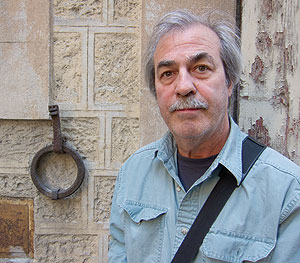
John Superti’s genealogical and historical investigations have yielded a treasure trove of cultural splendors, presented now at the Somerville Museum. – Photo by M. Bremen
By Maria A. Cortes
The Somerville Museum presents a new exhibition called Three Paths to Italy from a local artist John Superti. As its title suggests, the exhibition is divided into three parts. “Genealogy: Finding a Family History” lets the visitor into Superti family’s past. “Historic Preservation: Discovering and Documenting the Past” presents the artist’s newly finished book, “I Cavalli di Firenze” (“The Horses of Florence”), which depicts one of the unexplored elements of Italian folk art. “Art and Culture” introduces Superti’s photographs and collages inspired by his numerous trips to Italy.
A New York native, Superti has been working in Somerville as a stained glass artist for over thirty years. A search for his Italian grandfather’s birth certificate has turned into a real life adventure for John Superti and has significantly changed his artistic focus. He was able to discover many pictures of his family (and digitally restore them), as well as birth certificates of his grandparents and other documents. One of them belonged to his great grandfather, Leonardo Superti. According to the document, he was a tailor from Barletta, Italy. John Superti was fascinated with this discovery: “He was a tailor, and I am an artist, I used to work with glass. So, we both worked with patterns. Genealogy really gives you an insight of who you are and why you do what you are doing.” Superti also put together a step-by-step guide on how to start a genealogical search on your own. He hopes that his exhibition would encourage people to explore the history of their families.
On his frequent trips to Italy, John Superti made an interesting observation, “I noticed that in Florence many palazi‘, or palaces, have iron horse hitches called ferri‘, or irons, attached to their facades.” So common that Italians themselves pay little attention to them, for Superti “ferri” were rather interesting “creatures.” At first, he started taking pictures of them. Then, Superti started his research to find out that the horse hitches were an early form of Italian folk art, with the first ones made in the late 13th century and continuing to the early 20th century. “They were originally used to tether horses, but now are used only for decoration,” says Superti. With the generous help of his Italian friends and family, John Superti is ready to present his unique book “I Cavalli di Firenze” (“The Horses of Florence”), which he calls “his gift to Florence.” Previously unexplored, Italian horse hitches are rare pieces of art, many of which are now lost or stolen. With his book, John Superti is hoping to “help the history of Florence to be told.”
The third part of exhibition includes the artist’s photographs from Rome, Venice, and Napoli (Naples) and photo collages. “Ferro, Ferragamo, Fritto” is one of the notable Superti’s collages that mixes up one of his beloved horse hitches, a Ferragamo shoe and a fried artichoke. Photographs reflect Superti’s view on the country of his ancestors: “Religion, soccer, food and lots of laundry – that is Italy.” Pictures from Gaeta acquire a special “status” (and a separate room in the Somerville Museum): Gaeta is a sister city of Somerville. Somerville Museum invites everyone to share their pictures of Gaeta or bring the recipes of traditional Italian food.
John Superti’s Three paths to Italy will remain open until November 10 in the Somerville Museum. For more information about the exhibit or museum’s hours of operation, please visit www.somervillemuseum.org.















Reader Comments